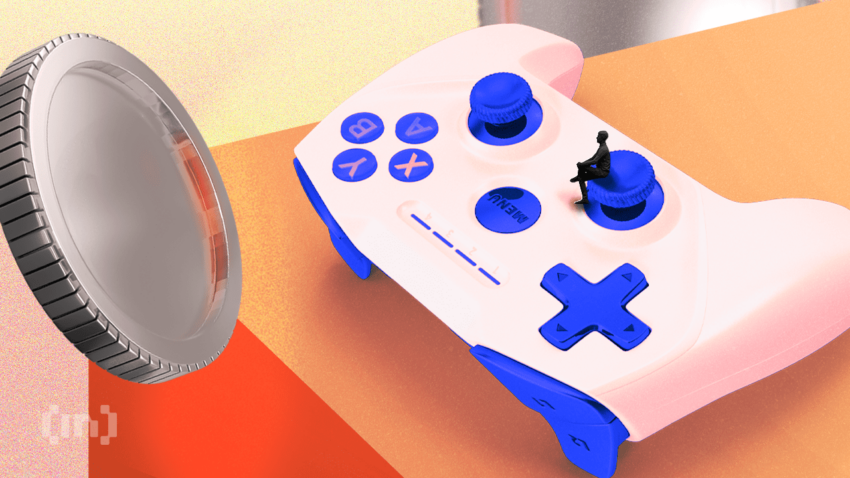Nemesis Downfall is a web3 gaming platform that combines competitive esports with true digital asset ownership. It aims to achieve this by delivering fast-paced, skill-driven gameplay in which players truly own their in-game assets. With its node sale now underway, the game is drawing even more attention from players and investors. This guide covers the game’s esports focus, gameplay mechanics, and economy, alongside a detailed breakdown of the node sale structure.
KEY TAKEAWAYS
➤ Nemesis Downfall is a competitive web3 FPS that integrates blockchain for decentralized asset ownership and rewards.
➤ The game features skill-based combat, multiple modes, NFT-based customization, and smooth blockchain integration.
➤ Nemesis Downfall nodes support game hosting, content distribution, and security while rewarding operators with $ND tokens.
➤ The Nemesis node sale follows a tiered pricing model, with costs increasing as more nodes are sold.
What is Nemesis Downfall?
Nemesis Downfall is a web3 multiplayer first-person shooter that blends fast-paced, skill-based gameplay with blockchain-based asset ownership. Unlike many blockchain games that prioritize tokenomics over experience, Nemesis Downfall focuses on delivering an engaging, competitive shooter game where players earn and own in-game assets.
➤ As of February 2025, the game is PC-client-based. Although, there are plans to expand it to mobile and consoles in the foreseeable future.
Nemesis Downfall features multiple game modes, such as battle royale, deathmatch, and one-in-the-chamber. The company claims the gameplay is comparable to top-tier shooters.
A key aspect that adds charm to the gameplay is its smooth web3 integration — players can acquire the game’s native $ND tokens and NFT-based skins without dealing with complex blockchain mechanics.
We are very excited about this next chapter for the Nemesis Downfall community,” says Cam Geary, CEO of Nemesis Downfall.
“Not only will we continue building upon our diverse game modes, immersive maps, character, and weapon customization, but we now have our node sale. This allows us to further integrate into web3, enhance our ecosystem, and incentivize and reward our node operators with our $ND token.”
Cam Geary, CEO of Nemesis Downfall
Nemesis Downfall’s rise in web3 esports
Nemesis Downfall is strategically positioning itself as a web3 esports title, as opposed to being just another play-to-earn (P2E) game.
The blockchain shooter prioritizes high-level competitive mechanics while integrating NFTs and token rewards in a way that feels natural to the so-called “mainstream” players. This way, the game ensures an optimal experience for both traditional FPS players and blockchain enthusiasts.
Nemesis Downfall’s ranked matchmaking, leaderboard system, and high-skill ceiling make it well-suited for organized competition.
A step toward mainstream esports: The Philippines tournament
The in-person Nemesis Downfall tournament in the Philippines in August 2024 demonstrated the game’s growing esports potential. The event featured competitive matches, real-time audience engagement, and prize pools.
The tournament’s success also demonstrated that web3 shooters can deliver a mainstream esports experience. It validated the game’s viability in traditional competitive settings. With increasing interest from both players and investors, future tournaments could further solidify Nemesis Downfall’s place in web3 esports.
Why web3 esports?
To cut a long story short, there are several benefits of integrating blockchain into esports, including, but not limited to:
- True ownership: Players own their in-game assets, unlike traditional games where items exist solely within centralized ecosystems.
- Decentralized rewards: Prize pools, in-game earnings, and marketplace sales can be transparent and verifiable on-chain.
- New revenue models: Players and node operators can earn from the game’s economy beyond traditional sponsorship and tournament winnings.
Overall, Nemesis Downfall is not just experimenting with web3 esports — it is pushing toward making decentralized gaming a legitimate competitive industry.
How Nemesis Downfall stacks up against top shooters
Broadly speaking, a shooter game must offer fluid mechanics, balanced combat, and replayability before becoming a benchmark in competitive gaming. Nemesis Downfall takes cues from the likes of Call of Duty, PUBG, and Valorant to ensure that it checks all three boxes.
It primarily focuses on:
- Skill-based gameplay rather than play-to-earn grinding.
- A wide range of game modes that appeal to both casual and hardcore players.
- Esports-ready infrastructure, including ranked matchmaking and tournaments.
However, there’s a catch — and it works in the players’ favor. While games like Valorant and CS:GO rely on centralized servers and marketplaces, Nemesis Downfall relies on blockchain to create a decentralized economy where players control their assets directly.
| Feature | Nemesis Downfall | Traditional FPS titles |
| Weapon skins | Tradeable NFTs, usable in-game | Locked to a single game |
| Ownership of in-game assets | Full player control | Developer-owned assets |
| Gameplay quality | High-quality FPS mechanics, competitive balance | Polished FPS experience |
| Game modes | Battle Royale, Team Deathmatch, One-in-the-Chamber | Varies by game, often similar options |
| Esports infrastructure | Ranked matchmaking, leaderboard system, tournament support | Established ranked modes and esports leagues |
| Skill-based progression | Player skill determines success, no play-to-earn grinding | Performance-based ranking, no blockchain integration |
| Server infrastructure | Decentralized nodes reduce reliance on centralized servers | Hosted on centralized servers controlled by developers |
Gameplay mechanics and web3 integration
Let’s start with the core gameplay mechanics, including both competitive and tactical depth:
Nemesis delivers a fast-paced, skill-driven gameplay built around multiple game modes. Its mechanics prioritize player skill, strategy, and teamwork.
➤ The lore: Nemesis Downfall is set in a dystopian world where the Antonym, an advanced alien species, conquered Earth to exploit its resources. For generations, humans lived under a strict surveillance state, confined to their homes with no rights but full provisions. Suddenly, the Antonym begin evacuating, which leaves Earth in chaos.
Players enter the Island of Trinity — battles ensue for abandoned technological relics in a fight for survival.
The game features:
➤ Multiplayer modes: Includes Battle Royale, Team Deathmatch, and One-in-the-Chamber.
➤ Weapons and loadouts: Customizable weapons, skins, and modular NFT attachments.
➤ Map variety: Different battlegrounds designed for tactical positioning and strategic play.
➤ Unlike most blockchain shooters that often suffer from clunky movement and lackluster gunplay, Nemesis Downfall promises tight controls, balanced combat, and high replayability.
Smooth web3 integration
Most web3 shooters generally tend to create unnecessary friction with complex wallet setups and blockchain-heavy mechanics. Nemesis removes these barriers by providing:
- Instant account creation: Players sign up with an email and password — no need for external wallets.
- Familiar FPS mechanics: Smooth gunplay, intuitive movement, and tactical team-based action.
- Balanced progression: Skill-based matchmaking and ranking systems ensure fair competition.
So, in a way, Nemesis Downfall is trying to keep its core familiar to traditional FPS players rather than forcing them into a crypto-native experience. This is a promising approach when it comes to bridging the gap between conventional and web3 gaming.
Understanding Nemesis Downfall nodes
Let’s start with a quick refresher on what Nemesis nodes do:
Nemesis Downfall nodes function as decentralized game servers by handling multiplayer hosting, content distribution, and network security.
Instead of relying on a centralized infrastructure, the game spreads these responsibilities across independently operated nodes. This approach ensures greater stability and decentralization.
Key functions of the nodes
➤ Game hosting: Nodes facilitate multiplayer matches, ranked competitions, and real-time gameplay.
➤ Content distribution: They distribute game files, patches, and in-game assets to players, which optimizes network performance.
➤ Network security: Nodes contribute to a trustless environment by verifying in-game transactions and protecting against manipulation.
How Nemesis Downfall ensures decentralization
➤ Distributed infrastructure: Unlike traditional gaming servers, Nemesis nodes collectively maintain uptime and prevent single points of failure.
➤ Automated check-ins: Each node performs 144 check-ins daily to ensure stability, with uptime points determining eligibility for rewards.
➤ Scalability: As more nodes join the network, processing power and storage capacity increase.
Nemesis Downfall node sale: What to know
The Nemesis Downfall node sale officially went live in late August 2024.
The sale follows a tiered pricing model, meaning the earlier you buy, the cheaper it is. Overall, 10,000 nodes are available for sale. As more nodes are sold, prices increase in structured phases:
| Node Tier | Quantity available | Price (USD) |
| A (whitelist and company) | 500 | $100 |
| B (whitelist and partners) | 500 | $200 |
| C (public sale) | 2,000 | $300 |
| D (public sale) | 3,000 | $400 |
| E (public sale) | 4,000 | $500 |
As you can see, the node sale structure is designed to encourage early adoption.
Node rewards and incentives
Nemesis Downfall nodes provide ongoing passive income for operators through $ND token rewards based on their contributions, with rewards based on uptime, performance, and network activity.
The reward structure is designed to incentivize long-term participation and ensure a sustainable economy.
- Node reward pool: A total of 850 million $ND tokens will be distributed to node operators over the first three years.
- In-game earnings share: Starting in Q4 2025, node operators receive 10% of all in-game rewards as part of an ongoing revenue share model.
- Deflationary token model: 20% of $ND tokens used in transactions are burned. This reduces supply over time and potentially increasing token value.
In addition to monthly token distributions, node owners receive discounts on in-game purchases, exclusive NFT skins, and premium content.
Put simply, participants can earn consistently just by operating a node. They don’t even have to actively play the game, which can potentially make it a good choice for those looking for long-term passive income.
In a nutshell: Nemesis Downfall nodes vs. conventional web3 project nodes:
| Feature | Nemesis Downfall nodes | Conventional web3 project nodes |
| Utility | Hosts gameplay, distributes content | Primarily secures blockchain transactions |
| Revenue model | Earns $ND tokens + in-game revenue share | Earns network token rewards only |
| Deflationary economy | 20% token burn on transactions | Can be inflationary, with high token emissions |
| Market demand | Nodes actively required for gameplay | Often dependent on speculative adoption |
| Fixed supply | Capped at 10,000 nodes | Many projects have unlimited or expanding nodes |
Who might buy a Nemesis node?
Nemesis nodes offer benefits for a variety of participants in the web3 space, including:
➤ Gamers: Players looking for passive earnings from the game they play while supporting its ecosystem.
➤ Investors: Those seeking long-term digital assets with fixed supply and growing demand.
➤ Web3 enthusiasts: Anyone interested in decentralization, earning from network contributions, and owning a stake in the future of web3 gaming.
Disclaimer: This article is for informational purposes only and should not be considered investment advice.
Dual blockchain infrastructure
Nemesis Downfall nodes operate within a hybrid blockchain infrastructure, using BNB Chain and GalaChain to support scalability, decentralization, and security.
➤ BNB Chain: Handles $ND token transactions, staking, and cross-chain transfers. Allows players to earn, trade, and stake $ND with minimal fees.
➤ GalaChain: Optimized for fast transactions, NFT minting, and in-game content management. Ensures smooth reward distribution and asset trading.
This dual-chain setup ensures:
- Low-cost transactions: GalaChain processes in-game microtransactions without Ethereum-level fees.
- Decentralized game hosting: Nodes distribute game files and patches across the network and reduces reliance on centralized servers.
- Scalability and security: BNB Chain provides liquidity and staking, while GalaChain enhances performance without sacrificing decentralization.
$ND tokenomics
The $ND token powers the Nemesis Downfall ecosystem by serving as both a reward mechanism and a utility token for in-game purchases, staking, and tournament entries.
Key aspects of $ND tokenomics
➤ Total supply: 20 billion $ND
➤ Deflationary mechanism: 20% of $ND rewards per match are burned to reduce overall supply.
➤ Cross-chain compatibility: $ND operates on BNB Chain and GalaChain, with a bridge enabling flexibility.
➤ Staking and rewards: Players and node operators can stake tokens or earn passive rewards from gameplay.
➤ Node earnings: 10% of all in-game rewards will be allocated to node operators starting in Q4 2025.
This structure ensures that token supply decreases as player activity grows, which could potentially increase long-term value for both players and investors.
What’s the future of Nemesis Downfall?
Nemesis Downfall is making strides to combine the best of traditional FPS shooters and blockchain gaming. So far, the project appears to be on a promising path, especially with its potential to attract mainstream gamers — a hurdle many web3 games struggle to overcome.
The gameplay stands strong on its own, even without the blockchain elements. However, as with any other web3 or crypto project, long-term success depends on adoption and market dynamics. So, if you’re considering investing in nodes, take the time to study the project’s fundamentals, assess the risks, and weigh the potential rewards before making a decision.
Disclaimer: This article is for informational purposes only and should not be considered investment advice. Always do your own research (DYOR).
Frequently asked questions
What is Nemesis Downfall?
How does Nemesis Downfall’s gameplay compare to traditional FPS games?
How does Nemesis Downfall’s gameplay compare to traditional FPS games?
What role do Nemesis Downfall nodes play?
What role do Nemesis Downfall nodes play?
What is the Nemesis Downfall node sale time-sensitive?
Disclaimer
In line with the Trust Project guidelines, the educational content on this website is offered in good faith and for general information purposes only. BeInCrypto prioritizes providing high-quality information, taking the time to research and create informative content for readers. While partners may reward the company with commissions for placements in articles, these commissions do not influence the unbiased, honest, and helpful content creation process. Any action taken by the reader based on this information is strictly at their own risk. Please note that our Terms and Conditions, Privacy Policy, and Disclaimers have been updated.




